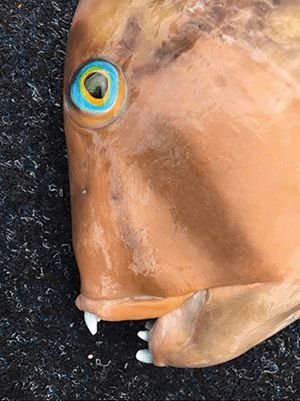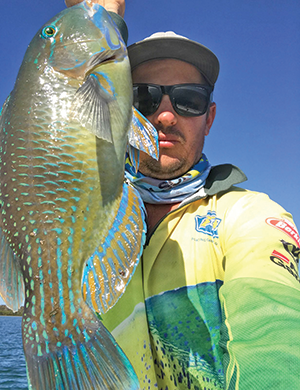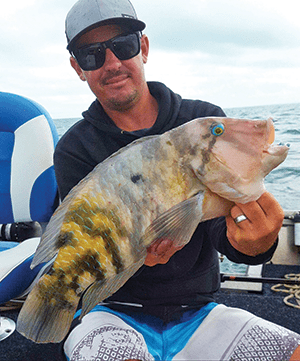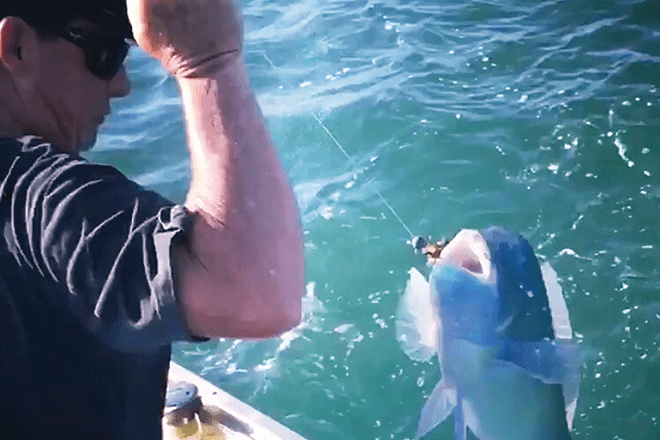WELL the jumper is well and truly gone and the boardshorts are on, which means summer is here, and with summer come the Moreton Bay tuskfish.
Right now the tuskies are in full swing and for me nothing is more fun than chasing these brutes in the island shallows of Moreton Bay.
The main species you will encounter are either blackspot tuskfish (also known as blue bone) or venus tuskfish. Pound for pound, these fish go as hard as any other fish out there, especially in shallow water.
My usual partner in crime is my old man and we have chased Moreton Bay tuskfish for over 10 years. During this time we have figured out methods for capturing these sometimes-frustrating fish.
Tackle
My dad and I differ in how we fish for tuskies. I like to fish as light as possible and enjoy the battle, whereas the old boy likes to fish heavy and stop them in their tracks before getting bricked.
Using these two methods works well to determine what mood the fish are in. If they are finicky, then obviously the lighter gear will get the fish but if you hook up to something decent you will be done over quickly.
The heavy gear can sit without a bite for an hour but if that big fish comes along then you’re in with a chance if you’re quick enough. When fishing the shallows for tuskies, I only use mono line because you need the abrasion resistance through the structure.
One touch on braided line and you’re finished. Often I’ll have five or more metres of chafing along the mono after a good fight. Be prepared to lose some tackle and tie a lot of knots, so not having to tie a braid to mono knot gets you back in the water quicker, resulting in more fish on that hot bite.
For my light setup, I like to use a Shimano 4500 Baitrunner coupled with a 7’ Wilson Live Fibre rod and 40lb Schneider mono. For my heavy outfit, I team a Shimano 6500 Baitrunner with an 8-15kg, 7’2” Wilson Live Fibre rod and 55lb Schneider line.



The Schneider has fantastic abrasion resistance and though it is a stiffer line, it still knots well.
My heavier setup will account for most fish in the bay but when that 5-6kg fish comes along I still have trouble bringing it to the surface.
My old man likes to use the good-old Alvey, as with its light free spool the fish don’t feel a thing when taking the bait. But with 80lb mono and the ability to stop a fish in its tracks by grabbing the reel, it provides your best chance at stopping a cracking tusky.
I find a stiff but longer rod will help pull the fish up and away when they are trying to get back to structure. As for hooks, you need something sharp, strong and not overly large because it’s always good to have your hook as hidden as possible. The hooks we use are Mustad Hoodlums in size 3-8 and in some instances bigger. Your hook needs to match the size of your bait.
Baits
When diving, I have witnessed Moreton Bay tuskfish swimming their food back to the structure and smashing into it. I have checked inside the stomach of tuskfish I’ve filleted and have seen all manner of crustaceans, shells and coral.
Offshore tuskfish feed completely differently to inshore tuskfish. Offshore, they can be readily caught all year round and will feed on squid, mullet, pillies and so on.
Inshore, blackspot tuskfish will mainly be caught in summer and will almost exclusively feed on crustaceans. While blackspot can be caught offshore, I am yet to hear of the pinker offshore tuskfish being caught in the bay.
Technique
Though tuskfish fight hard, sometimes they are so gentle that they will take your bait without any sign of a bite, resulting in you sitting there unaware for a long time. Don’t overlook even the slightest of bites and always have your rod in your hands because you only have about two seconds to stop a big tuskfish or you’ll be in the structure.
Double anchoring (one off the bow and one at the stern) is a must because if your boat is swinging around with the wind and current it is hard to notice a bite and you will get snagged much easier.
Moreton Bay tuskfish can be tricky to catch and sometimes frustrating but with persistence comes reward and what a great reward tuskfish are, rating an A+ on the table. They fight hard and you can target them with your kids in a small tinnie.
After all, these fish have accounted for some of my fondest memories with my dad.
So put the boat in the water over the holidays and have a crack.
For a Moreton Bay grass sweetlip guide, click here!
 Bush ‘n Beach Fishing Magazine Location reports & tips for fishing, boating, camping, kayaking, 4WDing in Queensland and Northern NSW
Bush ‘n Beach Fishing Magazine Location reports & tips for fishing, boating, camping, kayaking, 4WDing in Queensland and Northern NSW










I get quite excited reading some of the articles written by B’nB authors but I wish, especially for those of us who do not get to spend as much time on the water as they do, that they could be a touch more telling about where they fish. Adam’s ‘Tackling Moreton Bay Tuskfish’ is a case in point. The shallows of Moreton Bay islands as a where to fish reference is a pretty sweeping statement. Are there not some islands that fish better than others, that would enhance the chances of ‘tackling’ the brutes of the species. I am not suggesting that your writers be as specific as GPS marks but maybe just narrowing the choice … possibly something like “Green, Mud and Coochiemudlo are islands worth a try.”
Thank you,
Warren Cox